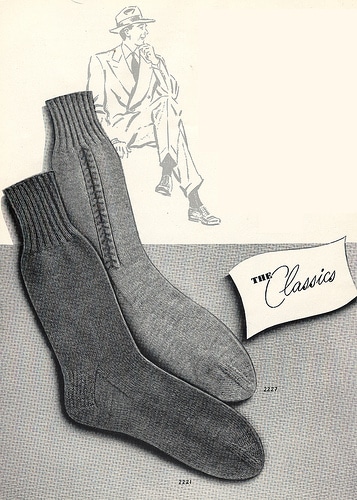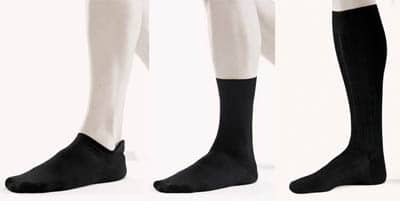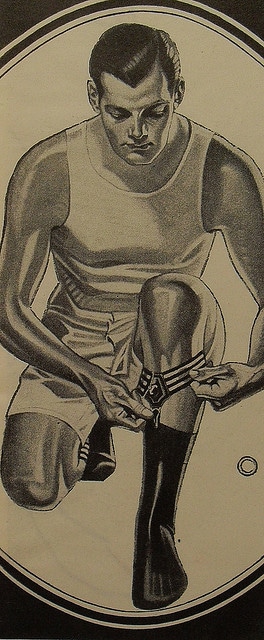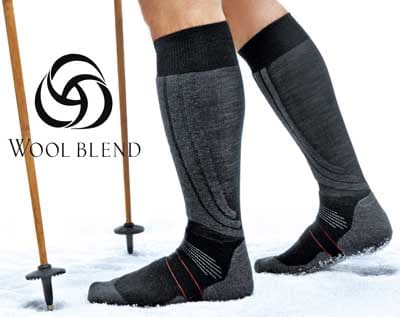
Why Socks?
Socks are an interesting piece of clothing; we pay so little attention to them and yet they’re central to our overall comfort in several ways: socks protect our feet from abrasion, wick away our perspiration, and keep our dew beaters snug in our shoes. They’re also a small detail that can either pull your outfit together or serve as an unwelcome distraction.
Today we’ll give this often overlooked piece of clothing a thorough look over, if for no other reason than to ensure that when you spend your hard earned dollars you are buying the best socks for your needs.
Common Rules Concerning Socks
1. Your socks should match one another and not have holes or visible stains
Now some of you are thinking this is incredibly obvious; however, I mention this rule for those of you who fail to see the problem here. Assuming you keep your shoes on and never expose your torn and mismatched socks, there very well may not be an issue. But for most of us, failing to heed this rule is going to lead to an embarrassing situation when we unexpectedly have to remove our shoes; instead of striking up a conversation with a potential business partner, we’ll be worried about concealing our protruding big toe.
Side Note – it was an embarrassing situation with torn socks at a Japanese Tea house that led entrepreneur Samy Liechti to form the company Black Socks. His genius idea? Provide men sockscriptions, where 3 pairs of black socks are delivered by mail every few months. Wish I would have thought of this!
2. Your socks should match your trousers
A man cannot go wrong following this advice, as it serves to create a streamlined look with no unnecessary color contrast until the eyes meet the shoes. Many men also like this rule as its rigidness leaves no room for interpretation and confusion.
However once a man has a sense of his own personal style, he should feel free to break this rule. Doing so enables him to introduce into his wardrobe a wide range of patterned and perhaps even lively colored socks that conservative dressers would avoid. I’m a bigger fan of a man coordinating his choice of sock with his neckwear and shoes; although more difficult than the aforementioned rule of matching your trousers, the tradition of coordinating your shoes, socks, and neckwear has a 100 year history and can help liven up an otherwise dull outfit.

It would be hard to find trousers patterned like this!
3. Wear knee length vs. ankle length socks
This rule is based off the belief that a gentleman should not expose his bare leg unintentionally. A bit archaic, I know, but it still holds sway nonetheless as the flash of white hairy skin when wearing a dark suit can be distracting. And that’s not what we want.

(Left) Low-cut sport, (Middle) Ankle-dress, (Right) Knee-length
In practice, this rule is hard to abide by as most sock manufacturers do not make socks that rise anywhere close to the knee. The extra material increases the cost of the sock by 25% or more, and most manufacturers are competing on price. If you want knee length socks you’ll need to look to menswear stores vs. most department stores and be willing to pay a bit more.
4. Your socks should match the dress level of the rest of your ensemble
If you’re wearing black-tie, then choose a quality, lightweight, knee-high sock with a sheen appearance. If you’re wearing a sport jacket and grey flannel trousers, heavy wool argyle socks work perfectly. Jeans, a nice t-shirt, and leather casual footwear call for a dark sock that simply pulls the shoes and denim together. A trip to the gym? Here’s where you wear those white tube socks.
Sock Construction
Hosiery knitting machines first appeared around the year 1600, but didn’t start to have a large impact on the industry until 1800 when inexpensive cotton made mass manufacturing profitable. Today modern circular knitting machines and the automation of most of the manufacturing process enables large manufacturers to churn out socks in huge numbers. This has been great in the sense of making socks affordable for everyone; the negative effect is that most socks today are made to be disposable and fit only a small percentage of men well. If you’ve ever bought a pair of tube socks at Wal-Mart that range in size from 6 to 12 you know what I’m talking about – you may get 12 for 6 dollars, but good luck on fit and durability.
Higher quality socks, on the other hand, are manufactured using both better materials and the process for manufacturing them is often 50% longer. More time is spent on creating stronger seams, a higher percentage of hand guided sewing is required, and higher quality controls are enforced. Also, quality sock manufacturers make a wider range of sizes. Although this adds complexity to the line from a manufacturing perspective, from the consumer side it translates into a better fit. On the downside, quality socks can cost 5 to 20 times more than their less expensive brethren. If you’re searching for quality socks, look for ones made in the US or UK as they will typically be constructed with greater attention to detail.
Interested in seeing this process? Check out this video on how socks are knitted, sewn, dyed, and formed in a modern factory.
FYI, socks can also be handmade by knitting, crocheting, or sewing fabric together. You’ll need a lot of time, but a pair made in this fashion can outlast almost anything produced by a machine.

While garters are considered rather old fashioned, they can be quite useful if your socks keep falling down as they keep you from tugging them back up all day long.
Sock Fiber Selection
Wool – The earliest yarns used in sock production were spun from wool. Today wool socks are hard to find in most box stores and their price makes them a luxury for those accustomed to paying a dollar a pair. Often blended with synthetic fibers to increase desirable properties such as strength and abrasion resistance, wool socks are great for hikers as they absorb moisture from the skin and release it outside the sock. In addition, wool has unmatched insulating properties and keeps feet warm in cold weather and cool in hot temperatures.
Cotton – The most common sock material, cotton fiber is inexpensive and durable. When blended with lycra or other man-made fibers it can hold its shape and conform to the foot providing an excellent fit. Cotton socks can be washed roughly with any type of detergent, and although its absorption and insulation properties aren’t on par with wool, its ease in maintenance and overall acceptable performance make it the choice for most.
Cashmere & Silk – A luxury blend suited for dress socks, a blend such as this looks at home when paired with quality dress shoes and a fine worsted wool suit. Lighter than wool, they provide similar benefits with less bulk.
Other fibers that are commonly blended with the above include nylon, acrylic, olefins, spandex, linen, bamboo, cashmere, and mohair. The purpose of these blends is to achieve desired properties in feel, performance, durability, and elasticity.
Types of Socks
Athletic Performance Socks – Athletic socks are worn to enhance a man’s physical performance. From the simple sport cotton tube sock to low-cut running socks with strong sweat wicking properties to specialty designed skiing socks meant to wick moisture and trap in heat, these socks at the least increase comfort and can in an extreme case help a snow sport enthusiast avoid frostbite.

Ski Performance Sock – Photo from Blacksocks.com
Dress Socks – Meant to be worn with a man’s suit or casual clothing, they come in a wide range of materials and for the most part stick to darker colors such as black, charcoal grey, medium grey, bottle green, brown, and burgundy. Lighter shades such as tan work well with lighter clothing. As for patterns, the most traditional one is the classic argyle. More modern “attention grabbing†colors and shades have been becoming more popular and are available from online men’s specialty stores.
Protective Socks – As bulk is not a concern here, protective socks utilize heavier weaves and higher concentrations of insulating fibers. Although this may compromise on fit, performance when it comes to extremity protection is maximized. Socks of this type range from wet suit footwear meant to keep the feet warm despite being wet to Polartec Powerstretch fleece socks meant to worn in extreme cold conditions for a solid week straight when hunting.
Are Socks Optional?
For many men socks are optional. Agree or disagree? Check out this classic AOM article “Going Sockless in the Summer” and leave your two cents in the comments section.
A Man’s Guide to Socks – Conclusion
Socks aren’t the first item in our wardrobe we give thought to; however, they are an important part of a man’s clothing. Like a weak link in a chain, poor quality socks matched with a high quality suit and shoes risks weakening the strength of your entire presentation. And they can keep your feet nice and comfortable whether you’re walking into a boardroom or hiking up a mountain. Understand your needs, work within your budget, and be prepared for whatever life throws at your feet.


